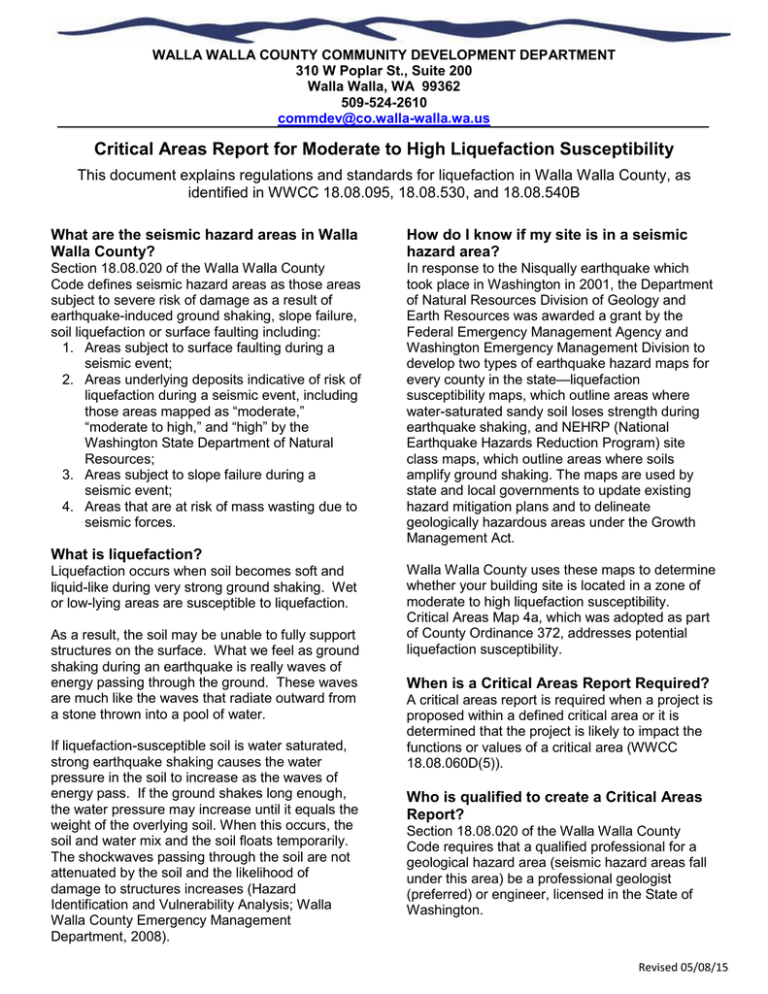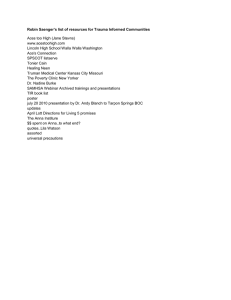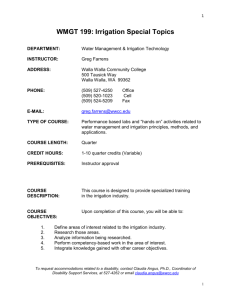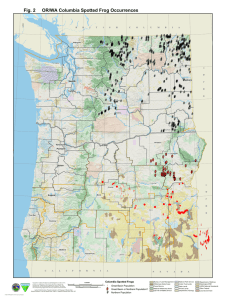Critical Areas Report for Moderate to High
advertisement

WALLA WALLA COUNTY COMMUNITY DEVELOPMENT DEPARTMENT 310 W Poplar St., Suite 200 Walla Walla, WA 99362 509-524-2610 commdev@co.walla-walla.wa.us Critical Areas Report for Moderate to High Liquefaction Susceptibility This document explains regulations and standards for liquefaction in Walla Walla County, as identified in WWCC 18.08.095, 18.08.530, and 18.08.540B What are the seismic hazard areas in Walla Walla County? How do I know if my site is in a seismic hazard area? Section 18.08.020 of the Walla Walla County Code defines seismic hazard areas as those areas subject to severe risk of damage as a result of earthquake-induced ground shaking, slope failure, soil liquefaction or surface faulting including: 1. Areas subject to surface faulting during a seismic event; 2. Areas underlying deposits indicative of risk of liquefaction during a seismic event, including those areas mapped as “moderate,” “moderate to high,” and “high” by the Washington State Department of Natural Resources; 3. Areas subject to slope failure during a seismic event; 4. Areas that are at risk of mass wasting due to seismic forces. In response to the Nisqually earthquake which took place in Washington in 2001, the Department of Natural Resources Division of Geology and Earth Resources was awarded a grant by the Federal Emergency Management Agency and Washington Emergency Management Division to develop two types of earthquake hazard maps for every county in the state—liquefaction susceptibility maps, which outline areas where water-saturated sandy soil loses strength during earthquake shaking, and NEHRP (National Earthquake Hazards Reduction Program) site class maps, which outline areas where soils amplify ground shaking. The maps are used by state and local governments to update existing hazard mitigation plans and to delineate geologically hazardous areas under the Growth Management Act. What is liquefaction? Liquefaction occurs when soil becomes soft and liquid-like during very strong ground shaking. Wet or low-lying areas are susceptible to liquefaction. As a result, the soil may be unable to fully support structures on the surface. What we feel as ground shaking during an earthquake is really waves of energy passing through the ground. These waves are much like the waves that radiate outward from a stone thrown into a pool of water. If liquefaction-susceptible soil is water saturated, strong earthquake shaking causes the water pressure in the soil to increase as the waves of energy pass. If the ground shakes long enough, the water pressure may increase until it equals the weight of the overlying soil. When this occurs, the soil and water mix and the soil floats temporarily. The shockwaves passing through the soil are not attenuated by the soil and the likelihood of damage to structures increases (Hazard Identification and Vulnerability Analysis; Walla Walla County Emergency Management Department, 2008). Walla Walla County uses these maps to determine whether your building site is located in a zone of moderate to high liquefaction susceptibility. Critical Areas Map 4a, which was adopted as part of County Ordinance 372, addresses potential liquefaction susceptibility. When is a Critical Areas Report Required? A critical areas report is required when a project is proposed within a defined critical area or it is determined that the project is likely to impact the functions or values of a critical area (WWCC 18.08.060D(5)). Who is qualified to create a Critical Areas Report? Section 18.08.020 of the Walla Walla County Code requires that a qualified professional for a geological hazard area (seismic hazard areas fall under this area) be a professional geologist (preferred) or engineer, licensed in the State of Washington. Revised 05/08/15 LIQUEFACTION HANDOUT What are the required contents of a Critical Areas Report for seismic hazard areas? Section 18.08.095 of the Walla Walla County Code outlines the general requirements for a critical areas report. Section 18.08.530 provides additional requirements relating specifically to geologically hazardous areas. Section 18.08.540B lists several requirements specifically for seismic hazard areas. The applicant may consult with the Director prior to or during preparation of the critical areas report to obtain County approval of modifications to the required contents of the report where, in the judgment of a qualified professional, more or less information is required to adequately address the potential critical area impacts and required mitigation (WWCC 18.08.100B) Preliminary Assessments A preliminary liquefaction assessment must be completed by a “qualified professional” as defined in Walla Walla County Code Section 18.08.020. A preliminary liquefaction assessment is not a substitute for a Critical Areas Report. The preliminary assessment will be used by the director to determine if a critical areas report will be required. The following list is to be used only as an example that shows what type of information that may be included in a preliminary assessment. Preliminary Site Assessment Contents 1. Provide an evaluation of the on-site soil profile based on material descriptions from available data sources. Water well reports could be consulted if the data is thorough and pertains to the site. 2. Summarize soil profile and analytic process used to conduct analysis. A table summarizing the assumed soil profile and soil property correlations may be used. 3. Include a statement specifying the accuracy of the analysis and all assumptions made and relied upon. 4. Provide a description of liquefaction susceptibility and strength of soils of the site. Make a recommendation regarding the presence or absence of a seismic hazard area as defined by Walla Walla County Code Section 18.08.020 as an area “with underlying deposits indicative of a risk of liquefaction during a seismic event.” What activities are allowed in a moderate to high liquefaction susceptibility zone without a Critical Areas Report? In addition to those activities allowed in Section 18.08.085 of the Walla Walla County Code, the following are allowed without submittal of a critical areas report in moderate to high liquefaction susceptibility zones: 1. Installation of fences; 2. Construction of new buildings with less than three thousand five hundred square feet of floor area or roof area, whichever is greater, and which are not residential structures or used as places of employment or public assembly; and 3. Additions that are two hundred fifty square feet or less to existing residences. For More Information Contact the Walla Walla County Community Development Department for more information. Ordinance No. 372: Critical Areas Ordinance Update and the County’s Critical Areas maps can be found at: www.co.walla-walla.wa.us. This document contains general information only and is subject to periodic change. Contact the Walla Walla County Community Development Department for specific details regarding current information. Revised 05/08/15



